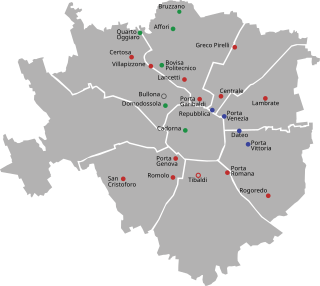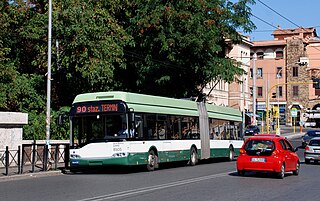History
The construction of a new basin (i.e. a "closed", i.e. a hydraulic engineering work aimed at overcoming the height difference imposed by the shape of the land), called Conca di Viarenna, was necessary to connect the dock, then Naviglio Grande and Naviglio Pavese, with the internal pit, [1] allowing it to overcome the difference in height. The basin was completed in 1439 and was used to make it easier to transport the blocks of Candoglia marble, arriving from the Naviglio Grande, as close as possible to the Milan Cathedral, whose construction with marble began in 1386-1387 following the gift of Gian Galeazzo Visconti. [2] Until then, the arrival of the material took place at the pond of Sant'Eustorgio (near the homonymous basilica), from which it was transported by road. Residues of the Conca di Viarenna are still visible in the first stretch of Via Conca del Naviglio (formed by the merging of two streets, Via Vallone and Via Olocati).
Also known as "Conca della Fabbrica", with obvious reference to the Duomo factory, the basin was then demolished by Ferrante Gonzaga to make room for the ramparts, and again built around the mid 16th century. [3] The construction was completed in 1558 and the fifteenth-century tombstones in the newsstand are still visible as evidence of the basin.

Milan Cathedral is the cathedral church of Milan, Lombardy, Italy. Dedicated to the Nativity of St Mary, it is the seat of the Archbishop of Milan, currently Archbishop Mario Delpini.

Prima Porta is the 58th zona of Rome, identified by the initials Z. LVIII. The name Prima Porta came from an arch of the aqueduct that brought water to the Villa of Livia, which formed over Via Flaminia a sort of gateway which travellers saw as the first indication of having reached Rome (Piperno).

Cernusco sul Naviglio is a town and comune in the Metropolitan City of Milan, Lombardy, northwestern Italy. With a population of 33,436 as of 2015 it is the 14th-largest municipality in the metropolitan city.

The Naviglio Grande is a canal in Lombardy, northern Italy, connecting the Ticino river near Tornavento to the Porta Ticinese dock, also known as the Darsena, in Milan. It drops 34 m over 49.9 km. It varies in width from 22 m to 50 m from Tornavento to Abbiategrasso, dropping to 15 m between there and Milan. Initially carries 63 m³ per second, 116 outlets take water to irrigate 500 square kilometres leaving the canal 12 m wide and carrying 12 m³ per second as it enters the dock.

Rozzano is a comune (municipality) in the Metropolitan City of Milan in the Italian region Lombardy, located about 9 kilometres (6 mi) south of Milan.

Turbigo is a comune (municipality) in the Province of Milan in the Italian region Lombardy, located about 35 kilometres (22 mi) west of Milan, along the Naviglio Grande canal. As of 31 December 2004, it had a population of 7,486 and an area of 8.5 square kilometres (3.3 sq mi).

The Naviglio Pavese is one of the canals making up the Navigli system in Lombardy, Italy. Once navigable, it is 33 km long and connected the city of Milan to Pavia, and through a flight of six locks to the River Ticino.

The Abbey of Santa Maria di Rovegnano is a Cistercian monastic complex in the comune of Milan, Lombardy, northern Italy. The borgo that has developed round the abbey was once an independent commune called Chiaravalle Milanese, now included in Milan and referred to as the Chiaravalle district.

Porta Genova is a neighborhood ("quartiere") of Milan, Italy, located within the Zone 6 administrative division. The name "Porta Genova" means "Genoa gate"; the district is named after a city gate of the old Spanish Walls of Milan, namely that leading to Genoa, that used to be in what is now Piazza Cantore. The only remnants of the old gate are the small buildings that used to house the customs offices, which replaced the Spanish gate in the 19th Century.

Milan, capital of the region of Lombardy, Italy, has 23 railway stations in use today; 17 are managed by RFI, while the remaining 6 are operated by FERROVIENORD. 4 more stations are currently in the planning stage for the city area: Canottieri, Dergano, Tibaldi and Zama.

Santa Maria alla Porta is a church in Milan, Italy.

The Oratorio di San Protaso is a church in via Lorenteggio, Milan, Lombardy.

The Zone 1 of Milan is one of the 9 administrative zones of Milan, Italy.

The Castello di Bereguardo is a medieval castle located on Via Castello 2 in the town of Bereguardo, Province of Pavia, region of Lombardy, Italy.

Municipio Roma III is the third administrative subdivision of Rome (Italy).

The following outline is provided as an overview of and topical guide to Milan:

The Visconti Castle or Castello Visconteo is a castle in the town of Cusago near Milan, Lombardy, Northern Italy. It was built in the 14th century by Bernabò Visconti and used as a hunting lodge by him and other members of his family. The castle underwent significant changes in the Renaissance period. Today it is in a state of neglect.

The Visconti Castle of Abbiategrasso is a mediaeval castle located in Abbiategrasso, Lombardy, northern Italy. It lies on the Naviglio Grande axis toward Milan. From its towers the navigation along the canal could be controlled. In the 15th century it was one of the preferred residences of the dukes and duchesses of Milan.

The Sanctuary of Madonna of Miracles is a church in Corbetta, province of Milan, Lombardy, northern Italy; it is dedicated to the Madonna of the Miracles.

The hydrography of Milan and the area of the neighboring municipalities is particularly complex, both for natural causes, given the conspicuous presence of rivers, streams and fountains that form a real water tangle, and for issues related to the work of canalization and diversion of waterways made by man, having their beginning during the Roman era, which led to the creation of numerous irrigation ditches, canals and lakes.



















